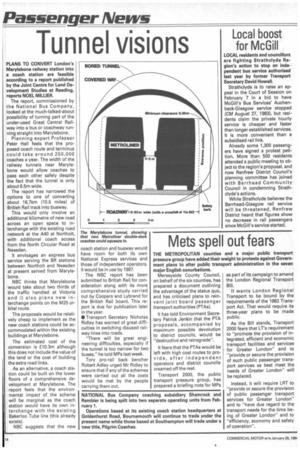Tunnel visions
Page 16

If you've noticed an error in this article please click here to report it so we can fix it.
PLANS TO CONVERT London's Marylebone railway station into a coach station are feasible according to a report published by the Joint Centre for Land Development Studies at Reading, reports NOEL MILLIER.
The report, commissioned by the National Bus Company, looked at the much-talked-about possibility of turning part of the under-used Great Central Railway into a bus or coachway running straight into Marylebone.
Planning expert Professor Peter Hall feels that the proposed coach route and terminus could take around 250,000 coaches a year. The width of the railway tunnels near Marylebone would allow coaches to pass each other safely despite the fact that the tunnel is only about 6.5m wide.
The report has narrowed the options to one of converting about 16.7km (10.5 miles) of British Rail track into busway.
This would only involve an additional kilometre of new road across an open space to interchange with the existing road network at the A40 at Northolt, with additional coach access from the North Circular Road at Neasden.
It envisages an express bus service serving the BR stations between Northolt and Neasden at present served from Marylebone.
NBC thinks that Marylebone would take about two thirds of the traffic handled at Victoria and it also plans new interchange points on the M25 orbital route.
The proposals would be relatively cheap to implement as the new coach stations could be accommodated within the existing buildings at Marylebone.
The estimated cost of the conversion is £10.3m although this does not include the value of the land or the cost of building the extra road links.
As an alternative, a coach station could be built on the lower floors of a comprehensive development at Marylebone. The report feels that the environmental impact of the scheme will be marginal as the coach station would have its own interchange with the existing Bakerloo Tube line (this already exists).
NBC suggests that the new coach station and busway would have room for both its own National Express services and those of independent operators. It would be in use by 1987.
The NBC report has been submitted to British Rail for consideration along with its more comprehensive study carried out by Coopers and Lybrand for the British Rail board. This report is due for publication later in the year.
• Transport Secretary Nicholas Ridley has warned of great difficulties in switching disused railway lines into roads.
"There will be great engineering difficulties, especially if the tunnel is too narrow for two buses," he told MPs last week.
Tory pro-rail back bencher Robert Adley urged Mr Ridley to ensure that if any of the schemes were carried out all the costs would be met by the people carrying them out.










































































